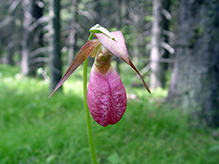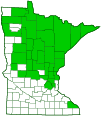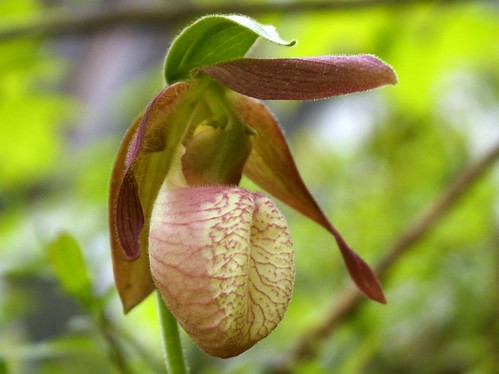pink lady’s slipper
(Cypripedium acaule)
Conservation • Wetland • Description • Habitat • Ecology • Use • Distribution • Taxonomy
Conservation Status |
|
|||||||
| IUCN Red List | not listed |
|||||||
| NatureServe | N5 - Secure SNR - Unranked |
|||||||
| Minnesota | not listed |
|||||||
Wetland Indicator Status |
||||||||
| Great Plains | FACW - Facultative wetland |
|||||||
| Midwest | FACW - Facultative wetland |
|||||||
| Northcentral & Northeast | FACW - Facultative wetland |
|||||||
Description |
||
Pink lady’s slipper is a 5½″ to 19¾″ tall, erect, perennial forb. It rises on a pair of basal leaves and a single leafless flower stalk (scape) from a long rhizome and widely-spaced roots. The rhizome is horizontal, slender, fleshy, and sometimes branched. The roots are white, fleshy or cord-like, and up to 13¾″ long. In the first two or three years after germination the plant lives entirely underground as a shapeless mass of cells (protocorm). In the third or fourth spring a single pair of ascending to spreading leaves rise directly from the rhizome. Each blade is elliptic, 3½″ to 9″ long, 1″ to 4″ wide. It sheaths the flowering stem at the base, is broadly angled at the tip, and is plaited or folded, like a fan. The upper surface is green. The lower surface is silvery and shiny. Both surfaces are covered with short glandular hairs. The margins are untoothed. The inflorescence is a solitary flower at the end of an erect stalk (scape). The scape is hairy, leafless, and round in cross section. A single leaf-like appendage (bract) subtends the flower. The bract is stalkless, lance-shaped, green, hairy, ⅞″ to 1¾″ long, and ⅜″ to ½″ wide. The flower has three sepals and three petals. The sepals are covered with glandular hairs. The upper sepal is elliptic to lance-shaped elliptic, yellowish-green to brown or purple, 1″ to 1½″ long, and 3 ⁄16″ to ⅞″ wide. It is arched over the inflated lower lip petal. The bract subtending the flower arches over the upper sepal like a hood. The two lateral sepals are fused together into a single structure (synsepal) that is located directly below the lip petal. The synsepal is egg-shaped to lance-shaped, ⅝″ to 2″ long, ¼″ to 1″ wide, and is similar in appearance to the upper sepal. The two lateral petals are linear lance-shaped to lance-linear, 1⅛″ to 1¾″ long, ⅛″ to ⅝″ wide, and similar in appearance to the sepals. They are bent abruptly downward to somewhat spreading and are slightly spirally twisted. The lower petal (lip) is inflated to form a large, showy, slipper-like, 1 5 ⁄16″ to 2⅜″ long, 1 3 ⁄16″ to 1 9 ⁄16″ wide pouch. It is pink to magenta or purple, with dark branching veins. It is covered with glandular hairs. The upper (dorsal) surface has a deep longitudinal fissure the length of the lip. Unlike other orchids, the filaments and style are not fused into a column. There are 2 stamens and an enlarged, modified, sterile stamen (staminode). The staminode is purplish-green and inversely egg-shaped to almost four-angled. It curves over the base of the lip petal and below the upper sepal. There is one style with a lobed stigma. The fruit is a single, erect, ellipse-shaped, ribbed, ¾″ to 1 9 ⁄16″ long capsule. The persistent bract partially encloses the base of the capsule. |
||
Height |
||
5½″ to 19¾″ |
||
Flower Color |
||
Pink with red veins |
||
Similar Species |
||
Habitat |
||
Dry to wet. Woods, swamps. Acidic soil. |
||
Ecology |
||
Flowering |
||
May 24 to July 10 |
||
Pests and Diseases |
||
|
||
Use |
||
|
||
Distribution |
||||
|
Sources |
|||
| 7/26/2023 | ||||
Nativity |
||||
Native |
||||
Occurrence |
||||
Uncommon |
||||
Taxonomy |
|||
| Kingdom | Plantae (Plants) | ||
| Subkingdom | Pteridobiotina | ||
| Phylum | Tracheophyta (Vascular Plants) | ||
| Class | Liliopsida (Monocots) | ||
Order |
Asparagales (Agaves, Orchids, Irises, and Allies) | ||
Family |
Orchidaceae (orchids) | ||
| Subfamily | Cypripedioideae (slipper orchids) | ||
Genus |
Cypripedium (hardy slipper orchids) | ||
| Subgenus | Cypripedium | ||
| Section | Acaulia | ||
Synonyms |
|||
Fissipes acaulis |
|||
Common Names |
|||
lady’s-slipper orchid moccasin flower pink lady’s slipper pink lady’s-slipper pink lady’s-slipper orchid pink ladyslipper pink moccasin flower pink moccasin-flower small pink lady’s-slipper stemless lady’s slipper stemless lady’s-slipper |
|||
Glossary
Bract
Modified leaf at the base of a flower stalk, flower cluster, or inflorescence.
Column
The united filaments and style of an orchid. The structure formed by the united filaments of plants in the Mallow family.
Protocorm
A tuber-like mass of cells on the seed of an orchid that precedes the production of above-ground parts.
Rhizome
A horizontal, usually underground stem. It serves as a reproductive structure, producing roots below and shoots above at the nodes.
Scape
An erect, leafless stalk growing from the rootstock and supporting a flower or a flower cluster.
Sepal
An outer floral leaf, usually green but sometimes colored, at the base of a flower.
Staminode
A modified stamen that produces no pollen. It often has no anther.
Synsepal
A floral structure formed by the partial or complete fusion of two or more sepals.
Visitor Photos |
|||||
Share your photo of this plant. |
|||||
| This button not working for you? Simply email us at info@MinnesotaSeasons.com. Attach one or more photos and, if you like, a caption. |
|||||
Tim Blumentritt |
|||||
I came across the link lady slipper for the first time in my life! |
|||||
 |
|||||
Bill Reynolds |
|||||
 |
|||||
MinnesotaSeasons.com Photos |
|||||
 |
|||||


Visitor Videos |
|||
Share your video of this plant. |
|||
| This button not working for you? Simply email us at info@MinnesotaSeasons.com. Attach a video, a YouTube link, or a cloud storage link. |
|||
Other Videos |
|||
| MyNature Apps; Identifying Pink Lady's Slipper, Cypripedium acaule MyNatureApps |
|||
About
Uploaded on May 31, 2011 How to identify Pink Lady's Slipper, Cypripedium acaule also known as Stemless Lady's-slipper, or Moccasin Flower. www.mynatureapps.com |
|||
| Cypripedium acaule - Laddy Slipper Orchid MrSkillwater |
|||
About
Uploaded on May 31, 2010 No description available. |
|||
| Dance Of The Lady Slippers.m4v Douglas Foulke |
|||
About
Published on Jun 5, 2012 A time lapse look at Lady Slipper Orchids, (Cypripedium acaule), growing in Brookfield, CT. |
|||

Visitor Sightings |
|||||
Report a sighting of this plant. |
|||||
| This button not working for you? Simply email us at info@MinnesotaSeasons.com. Be sure to include a location. |
|||||
| Tim Blumentritt 6/6/2021 |
Location: Wisconsin I came across the link lady slipper for the first time in my life! |
||||
| Bill Reynolds 6/18/2004 |
Location: St. Louis Co. |
||||
MinnesotaSeasons.com Sightings |
|||||

|
Created: Last Updated: © MinnesotaSeasons.com. All rights reserved. |





